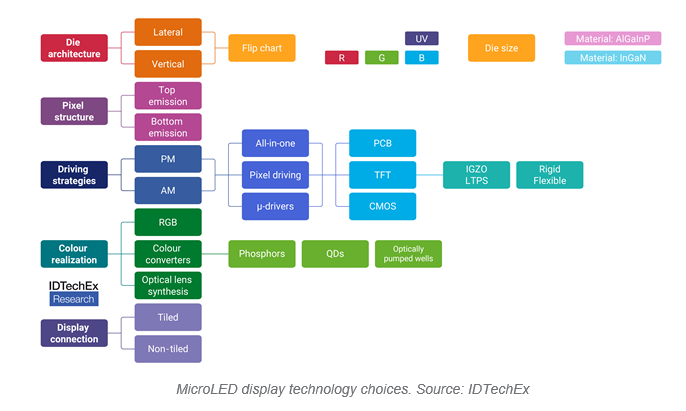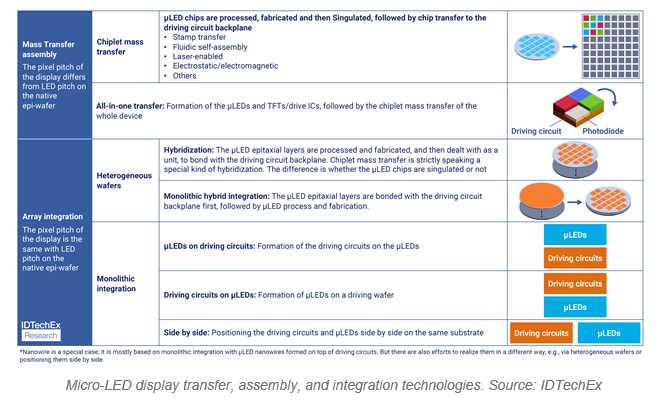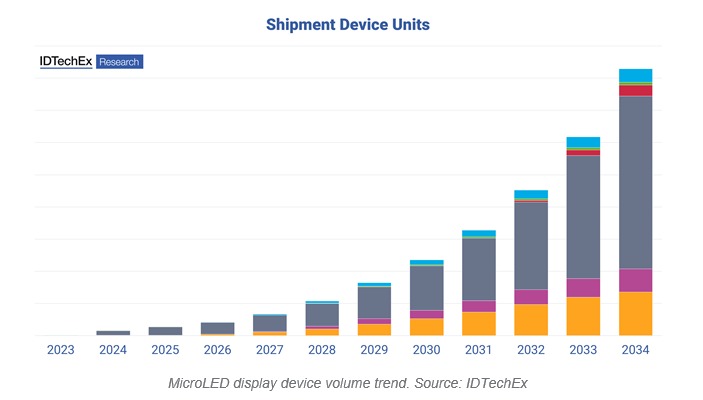Unlocking the future of displays with MicroLED tech
Dr Xiaoxi He, Research Director at IDTechEx, talks about how MicroLED displays are the one innovation that shines brilliantly in the ever-evolving landscape of visual technologies.
These remarkable MicroLED displays are poised to disrupt the industry, and IDTechEx are going to delve into the incredible potential of MicroLED technology. The journey through this transformative landscape is guided by the insights from IDTechEx's extensive report, ‘Micro-LED Displays 2024–2034: Technology, Commercialization, Opportunity, Market and Players.’
MicroLED: the next frontier
MicroLED displays, believed by many to be the next generation of display technology, have captivated the imaginations of industry players in LEDs, displays, OEMs, and materials. What sets MicroLEDs apart is their composition of self-emissive inorganic LEDs in the micrometre range, each functioning as a subpixel. These LEDs typically lack traditional packaging and substrates, setting the stage for a unique and exciting production process. However, the MicroLED in Package (MIP) has recently become a popular option for commercial products.
Unveiling the value propositions:
MicroLED displays offer a host of compelling value propositions, reshaping the way visual content is experienced:
- Wide colour gamut: these displays offer a breathtaking array of vivid and true-to-life colours, elevating visual experiences to unprecedented levels.
- High luminance: ensuring exceptional brightness even in well-lit conditions, such as outdoors, MicroLEDs shine with unwavering brilliance.
- Low power consumption: MicroLEDs are renowned for their energy efficiency, contributing to extended device battery life and reducing the environmental footprint in certain scenarios.
- Stability and longevity: built to last, these displays provide exceptional stability and boast impressively long operational lifetimes.
- Wide viewing angles: say goodbye to restricted viewing angles; MicroLEDs offer clear visibility from various perspectives, ensuring a rich visual experience for all.
- High dynamic range: the exceptional contrast and lifelike visuals provided by MicroLEDs place them at the forefront of high dynamic range displays.
- Fast refresh rate: with swift screen updates, MicroLEDs create seamless user experiences, whether gaming, watching sports, or streaming favourite content.
- Transparency: MicroLEDs introduce the potential for transparent display applications, opening doors to futuristic design possibilities.
- Seamless connection: the display of the future is devoid of disruptive seams, thanks to MicroLEDs' ability to create bezel-free, uninterrupted, large-format screens.
- Sensor integration capability: these displays can seamlessly incorporate integrated sensors, ushering in a new era of interactive experiences that transcend traditional boundaries.
Application-dependent revolution
The journey of MicroLED displays involves two critical considerations: their ability to replace existing technologies, especially OLED and OLED, and their ability to open up new applications. This transition is application-dependent. For instance, LCDs, which dominate displays under 65”, have inherent size limitations. OLEDs are rapidly gaining market share, particularly in smartphone displays, while QD-LCDs are capturing the premium TV market. MicroLEDs need to identify their unique value propositions to secure their place in the competitive landscape.
MicroLED displays do more than cater to existing applications; they unlock new possibilities. With features like seamless tiling, these displays enable standard MicroLED modules to form larger, customised shapes with even more flexible features. The integration of sensors adds an interactive dimension to displays, paving the way for a future of immersive experiences.
The transition to autonomous vehicles and smart technologies has placed new demands on display technologies. MicroLEDs are positioned to meet these emerging needs, setting the stage for a profound transformation in the display industry. It has been seen that MicroLEDs can especially play a role in four applications: large video displays/large TVs, automotive displays, augmented reality, and smart watches/wearables. The versatility of MicroLEDs is a testament to their transformative power.
The cost conundrum
Unlike OLED and LCD, where cost relates to the display area, the cost of a MicroLED display's front plane hinges on the number of LEDs, which is related to the display resolution. As a result, fabricating a smartphone with a comparable resolution to a TV may yield similar cost projections rather than drastically lower expectations.
Navigating challenges
While the promises of MicroLEDs are remarkable, there are challenges to overcome on the path to their widespread adoption. Achieving extremely high resolutions with small MicroLEDs remains technically and manufacturing demanding and costly. Some value propositions may hold less significance for specific applications due to elevated costs. Massive technology routes are available within the MicroLED display space, making the commercial direction less clear. Even within the mass transfer/integration space, many possible approaches exist.
Get informed
When embarking on this journey, it is essential to understand the current status, challenges, and market opportunities that accompany the integration of MicroLED displays. While the promises are grand, the path forward requires a comprehensive assessment of possibilities and opportunities.












